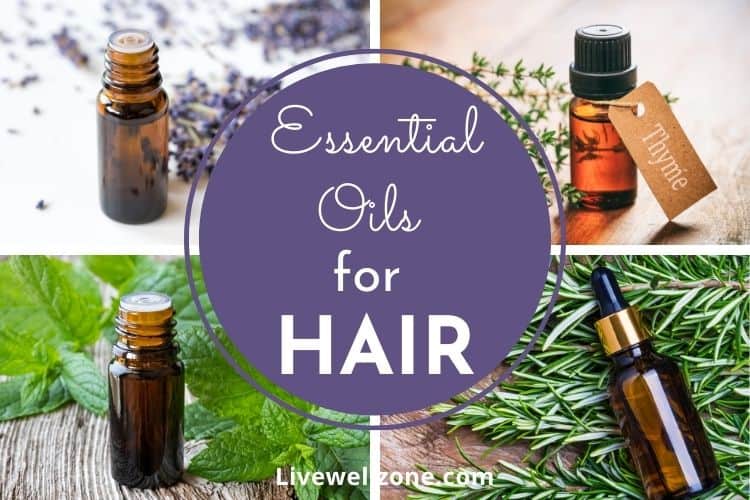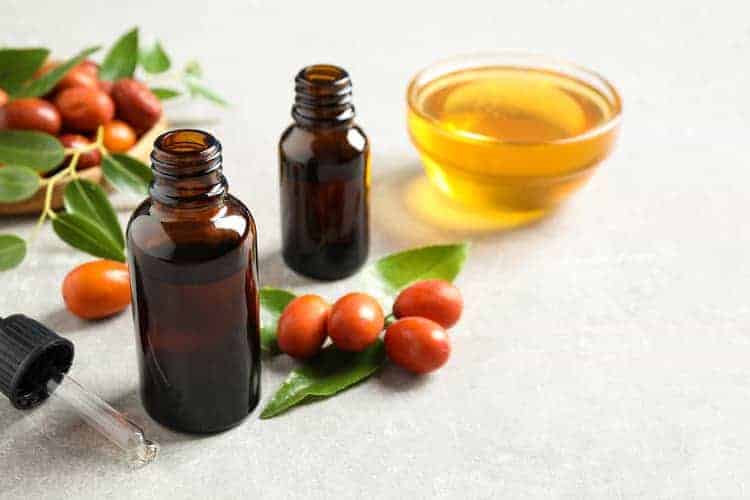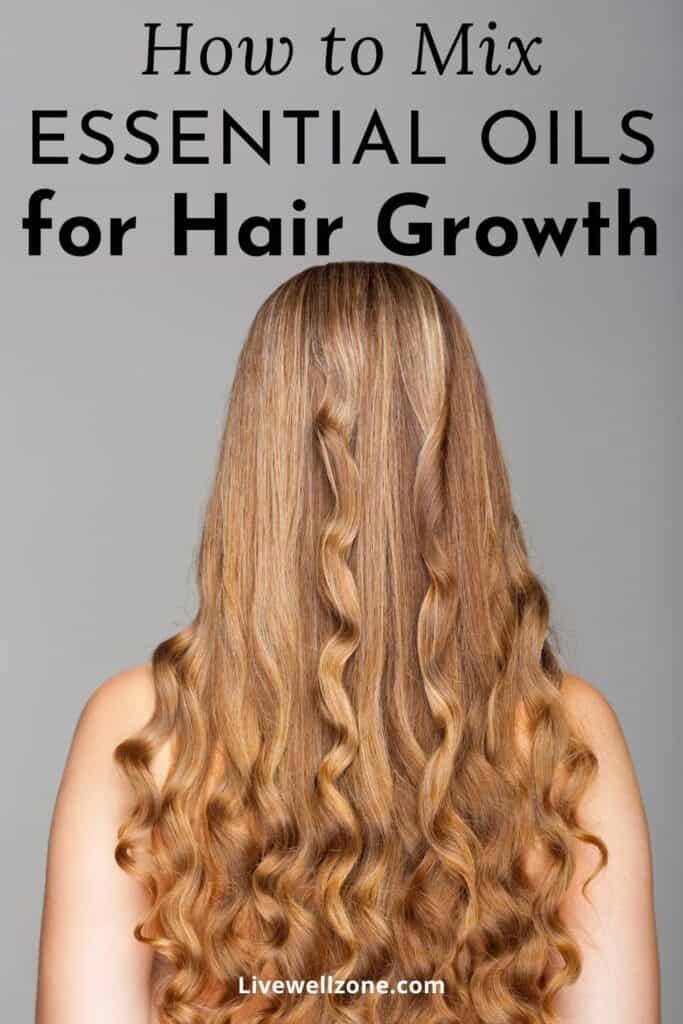
With about 130 essential oils available to us, knowing which ones to use for hair and how to use (i.e. dilute) them can be a little confusing. Plus, many of the DIY recipes out there don’t always give you the formula for figuring out how many drops of essential oil to use. Well, all of that is about to change because in this on how to mix essential oils for hair growth we’re going to look at:
- The top essential oils that encourage hair growth.
- How to dilute essential oils correctly for scalp application, including the best dilution ratios to use for each oil.
- Tips for mixing essential oils into shampoo.
Note: this post contains affiliate links and I earn a commission (at no additional cost to you) if you use them to make a purchase.
BEST ESSENTIAL OILS FOR HAIR HEALTH

1. Coffee
Coffee essential oil is often left out of many hair growth discussions. This is surprising given that there’s some pretty eye-catching research around caffeine and hair growth.
For example, a 2014 study showed that caffeine elongates the hair shaft and prolongs the anagen (active) phase of hair growth. In addition, the same study revealed that female hair follicles actually respond more to caffeine’s growth-promoting effects (compared to male hair follicles).
Another study compared a 0.2% caffeine-based liquid and 5% minoxidil for the treatment of androgenetic alopecia in men. After 6 months, the caffeine remedy was found to be as effective at minoxidil. In addition, caffeine didn’t have side effects such as itchy scalp (which is common with minoxidil).
Side note: if you’ve heard about this Vegamour hair serum, then you might be interested in knowing that one of its main active ingredients is caffeine 🙂
2. Rosemary
Rosemary is a member of the mint family that has historically been used – in tea and essential oil form – as a natural hair growth aid.
When compared to modern hair loss remedies, research shows that rosemary oil is just as effective. To illustrate this, let’s take a look at a study that was published in 2015.
In that study 100 men with androgenetic alopecia (hair loss associated with the hormone DHT) were split into two groups:
- One group used a rosemary lotion (equivalent to 1% dilution) twice a day.
- The other group used a 2% solution of minoxidil (the active ingredient in Rogaine) twice a day.
After 6 months of following this protocol, the study revealed that both groups had an increase in hair growth. In addition, the rosemary group had less side effects compared to the minoxidil (which experienced more itching)
Aside from the above benefits, it’s also worth noting that rosemary oil can be used for dandruff and it is also very soothing to an inflamed scalp. If left untreated, both dandruff and scalp inflammation can impact hair growth.
3. Thyme
Just like rosemary, thyme is also a member of the mint family. And according to a study published in 1998, thyme oil – in combination with other oils – promotes hair growth in people diagnosed with alopecia areata (an autoimmune condition that results in hair loss).
Similar to other essential oils, thyme works by stimulating blood flow to the scalp. Since blood carries nutrients, it’s no surprise that this results in hair growth.
In addition, thyme is anti-inflammatory and calming to an inflamed scalp.
Now one thing to note about thyme is that there are two types: thyme linalool (which can be used at dilutions of up to 4%) and thyme thymol (which can be used at dilutions of up to 1.3%).
Because the dilution threshold for thyme thymol is so low, that also means that it’s much easier for it to irritate the skin. So, consider using only thyme linalool for DIY haircare and skipping thyme thymol entirely.
4. Lavender
Lavender is another oil that has been shown to work together with thyme oil for promoting hair growth in alopecia areata patients.
In addition, a study on female mice showed that lavender oil stimulates hair follicles and supports new growth (source). More specifically, the study compared the effects of the following:
- 3% lavender oil
- 5% lavender oil.
- 3% minoxidil.
- jojoba oil.
- saline solution.
After 4 weeks the following changes in hair growth were observed:
- 3% lavender group: 90% hair growth.
- 5% lavender group: 95% hair growth.
- 3% minoxidil group: 98% hair growth.
Lastly, as with all the other oils on this list, lavender also helps alleviate dandruff and has anti-inflammatory properties that support overall scalp health.
5. Cedarwood
When used with rosemary, lavender and thyme, cedarwood has been shown to support hair growth in alopecia areata patients.
In addition, cedarwood (the Atlas and Virginian varieties) are said to help with dandruff and scalp health (source).
6. Tea Tree
A healthy scalp is essential for hair growth and so, using an oil like tea tree can go a long way toward supporting hair growth.
Tea tree is an all around anti-inflammatory that works well as a natural remedy for inflamed scalp conditions.
In addition, tea tree oil’s antimicrobial properties have been shown to be effective against pityrosporum ovale, a fungus that is associated with the development of dandruff (source).
7. Peppermint
Even though most of the research on peppermint oil and hair growth has been done mainly with mice, the results so far have been quite impressive. For example, this study published in 2014 examined the effects of the following on hair growth in mice:
- 3% peppermint oil.
- 3% minoxidil.
- Jojoba oil.
- Saline solution.
According to the results, peppermint oil had “the most prominent hair growth effects.” Most notably, peppermint oil:
- Increased the number of hair follicles.
- Increased the depth of hair follicles (from the dermis to the subcutis).
Basically, peppermint oil encourages the hair to stay in the anagen (active) phase, which leads to an observable increased in hair growth.
In addition, it’s worth noting that peppermint is very high in menthol, which is a terpene (we talked about this with rosemary oil too!). Menthol plays two important roles in hair growth:
- stimulates blood flow to the scalp.
- acts as a penetration enhancers for beauty products. So, when used in a hair growth blend, that menthol helps to the body absorb more of the beneficial ingredients.
HOW TO DILUTE AND USE ESSENTIAL OILS FOR HAIR (WITH RECIPES)

1. Choose a Carrier Oil
| Oil | Characteristics |
|---|---|
| Almond | light to medium-weight oil with medium absorption |
| Argan oil | light and easily absorbed |
| Castor oil * | very slow absorption |
| Grapeseed oil | very lightweight and easy to absorb |
| Jojoba oil | closest in composition to sebum; very easily absorbed |
| Herb infused oil | oils infused with herbs like horsetail, fenugreek, nettle or aloe vera powder are rich in nutrients that boost hair growth and thickness. To learn more about these oils, read my detailed guide on how to infuse herbs in oil for hair growth. |
* since heavy oils like castor oil are slow to absorb, that can hinder your scalp’s ability to fully benefit from essential oils. So, if using castor oil, combine it with other easy-to-absorb, lightweight oils.
2. Choose A Dilution Ratio
Since scalp skin is pretty similar to the skin on the rest of your body, it’s best to follow the general guidelines for topical use of essential oils. This means starting with a dilution of 1-3%.
That said, do remember that:
- Each essential oil also has its own dermal limit. For example, the dermal limit for peppermint oil is 5%. This means that in general, most people (there will always be exceptions!) can apply a 5% peppermint blend to their skin without the risking of irritation.
From personal experience, I found 1% and 2% dilutions to be weak. I have been happy with 3% and 4% blends (equal parts peppermint, rosemary and lavender). In both cases, I didn’t experience any irritation.
Below is a chart showing you how many drops of essential oil and carrier oil to use for each dilution (source).
| 1/2 oz carrier (1 Tbsp) | 1 oz carrier (2 Tbsp) | |
|---|---|---|
| 1% | 4 drops | 9 drops |
| 2% | 9 drops | 18 drops |
| 3% | 13 drops | 27 drops |
| 4% | 18 drops | 36 drops |
| 5% | 22 drops | 45 drops |
Now, here are the dermal limits for specific oils (based on information from the Plant Therapy brand of oils).
| Essential oil | Dilution for topical use |
|---|---|
| Coffee oil | up to 4% |
| Rosemary 1,8-cineole oil | up to 4% |
| Thyme linalool oil | up to 4% |
| Lavender oil | up to 5% |
| Cedarwood oil (Atlas or Virginian) | up to 4% |
| Peppermint oil | up to 5% |
| Tea tree oil | up to 5% |
Given that dermal limits vary for each oil, how do you figure out how much to use in a blend that has more than one oil? For example, let’s say you’re making a 5% oil in a 1 ounce bottle, with peppermint and cedarwood. This is how I approach it:
- For a 5% dilution in a 1 ounce bottle you need 45 drops.
- Since peppermint has a dermal limit of 5%, that equates to maximum of 30 drops peppermint oil.
- Cedarwood has a dermal limit of 4% which equate to a maximum of 24 drops cedarwood oil.
If you add up 30 and 24 you get 54 drops. This is more than the 45 drops you need a 5% blend.
So you can do any combination of drops that totals 45 drops. Here are some example of combos you could use:
- 30 drops peppermint and 15 drops cedarwood.
- 23 drops peppermint and 22 drops cedarwood.
- 28 drops peppermint and 17 drops cedarwood.
You get the idea 🙂
3. Blend & Store
It’s always best to store your essential oil blend in a dark, glass bottle.
A dark bottle helps to preserve the blend while the glass prevents the bottle from warping (which can happen if you put essential oils in a plastic bottle!).
Now, to wrap up this section, here are some recipes that you can try for yourself. They all use a 3% dilution.
| Recipe | Ingredients |
|---|---|
| Hair Growth Recipe 1 | 13 drops rosemary 14 drops peppermint 1 ounce of carrier oil |
| Hair Growth Recipe 2 | 8 drops rosemary 8 drops peppermint 6 drops cedarwood 5 drops thyme linalool 1 ounce of carrier oil (such as jojoba) |
| Hair Growth Recipe 3 | 8 drops peppermint 10 drops lavender 9 drops tea tree 1 ounce of carrier oil (such as jojoba) |
4. Apply several times a week
To get the most out of hair growth oil use it nightly or at least every other night as follows:
- apply a few drops directly onto your scalp.
- massage your scalp for 2 to 3 minutes.
- let the oils sit on your scalp overnight.
- if desired, shampoo your hair the next morning.
FAQs ABOUT USING ESSENTIAL OILS ON HAIR
Can I mix essential oils in my shampoo?
Adding essential oils to your shampoo is another common option for supporting hair growth. However, since the oils don’t stay on your head for very long, it’s not clear just how helpful this approach can be.
Nonetheless, if you’d like to give it a go, simply follow the dilution guidelines we already discussed earlier.
Here’s an example of how you to mix 8 oz of shampoo with essential oils, at a 3% dilution:
- Fill an applicator bottle with shampoo.
- Add 216 drops of essential oils.
- Seal the bottle and roll the bottle between the palms of your hand to mix the contents.
- Use the shampoo the way you’d normally use any other shampoo.
- Rinse thoroughly.
Which is the best rosemary oil for hair growth?
Rosemary 1,8-Cineole is generally considered the best type for hair growth.
Does rosemary oil block DHT?
Rosemary oil has been shown to encourage hair growth in people with androgenetic alopecia (which is linked to DHT). Therefore, it’s possible that rosemary is able to produce these successful by acting specifically on DHT.
CONCLUSION
Based on the results from multiple studies, it’s clear that essential oils are one of the best natural hair growth aids you can use. And you don’t need a whole lot of oils to get started either. Just 2 or 3 is enough to make a very potent blend.
Have fun coming up with your own signature hair growth oil!

You Might Also Enjoy:
How To Use Peppermint Tea For Hair Growth and Shine
Best Carrier Oils for Hair Loss and Regrowth: A Complete Guide
Rosemary vs Peppermint Oil for Hair Growth: Which Should You Use?
DIY Lavender Essential Oil Recipes for Hair Growth & Thickness
Lightweight Oils for 4C Hair: Reduce Breakage and Promote Growth
How to Infuse Herbs In Oil for Hair Growth: Best Herbs and Oils, Fastest Method and DIY Recipe
How To Dilute Essential Oils For Skin: Complete Guide for Face and Body
7 Carrier Oils That Have No Scent (great for skin, hair and other DIYs!)

